Lochhead on Marketing
184 Building Your Digital Reputation with Josh Greene, CEO of The Mather Group
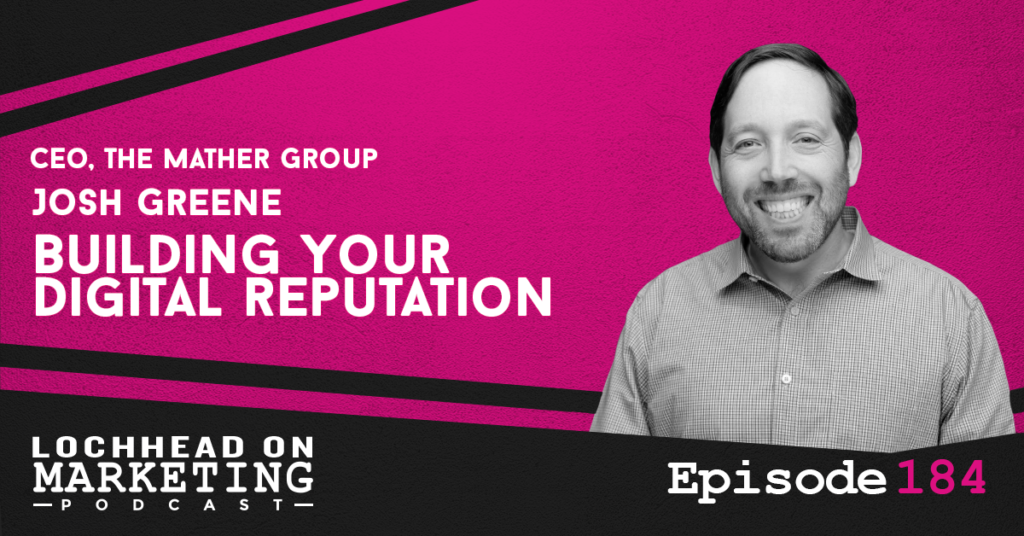
Podcast (lochheadonmarketing): Play in new window | Download (Duration: 1:09:33 — 47.8MB) | Embed
Subscribe: Apple Podcasts | Spotify | RSS | More
On this episode, we have a powerful dialogue with our guest, Josh Greene about what it really takes to build your reputation online and do legendary marketing in the digital world.
Josh Greene is the CEO of The Mather Group. In a world of digital marketing BS, sophomores hacks and self-congratulatory vanity metrics, Josh is the real deal.
Welcome to Lochhead on Marketing. The number one charting marketing podcast for marketers, category designers, and entrepreneurs with a different mind.
Josh Greene on Marketing and Reputation Management
The episode starts off with a discussion about marketing trends and reputation management with Josh Greene. They touch upon the impact of AI on marketing strategies and delve into reputation management techniques. Christopher highlights how individuals with negative reputations try to bury their past misdeeds in online search results. Josh explains that reputation management involves manipulating search engine rankings to push down negative content and make it less visible, while at the same time providing more positive information about you or your company.
They also touch on the evolving landscape of SEO (Search Engine Optimization), with Josh emphasizing that SEO is not dead but constantly changing. He notes that traditional SEO tactics, such as keyword optimization, have evolved due to changes in Google’s algorithms and the increasing importance of AI-driven queries.
Josh Greene on what is the Internet thinking about you
They also discuss the topic of the evolving landscape of SEO and the impact of AI, particularly in large language models like ChatGPT and Bard. As mentioned earlier, Josh highlights how SEO has evolved beyond optimizing for Google to also include considerations for AI-driven queries. He then emphasizes the importance of managing one’s online reputation in this context.
On the topic of AI, Christopher shares his experience with ChatGPT, mentioning how it produced relevant results related to category design, which led him to ponder the connection between AI training data, the internet’s content, and these AI models’ abilities to provide meaningful information. He also mentions that experts in various fields, including category design, are actively teaching AI models to enhance their understanding and capabilities.
Josh Green on how to stand out from the crowd
They then discuss how to stand out in the digital landscape, particularly in the context of AI and SEO. Josh explains that AI models like those used by Google rely on credible sources, with Wikipedia and Google’s patent tool being primary sources. He emphasizes that credibility, links, and signals play a significant role in determining the relevance of content for AI models. Much like in SEO, authoritative content with strong signals will have a more substantial impact.
Christopher adds that AI is evolving similarly to SEO and mentions that some individuals are already trying to exploit AI for personal gain by selling courses on how to manipulate AI models. He highlights the importance of providing valuable content to help people rather than merely trying to stay ahead of trends or exploit emerging technologies.
They both agree that the key to success in the digital age, whether in AI or SEO, is delivering valuable content and expertise to genuinely assist others rather than chasing quick fixes or trends promoted by self-proclaimed gurus. They also note that having a real impact requires substance and credibility, not just buzzwords.
To hear more from Josh Greene and on how you can build your online reputation, download and listen to this episode.
Bio
Links
Connect with Josh Greene!
We hope you enjoyed this episode of Lochhead on Marketing™! Christopher loves hearing from his listeners. Feel free to email him, connect on Facebook, Twitter, Instagram, and subscribe on iTunes!
183 What Barbie Can Teach Tech CEOs About Marketing
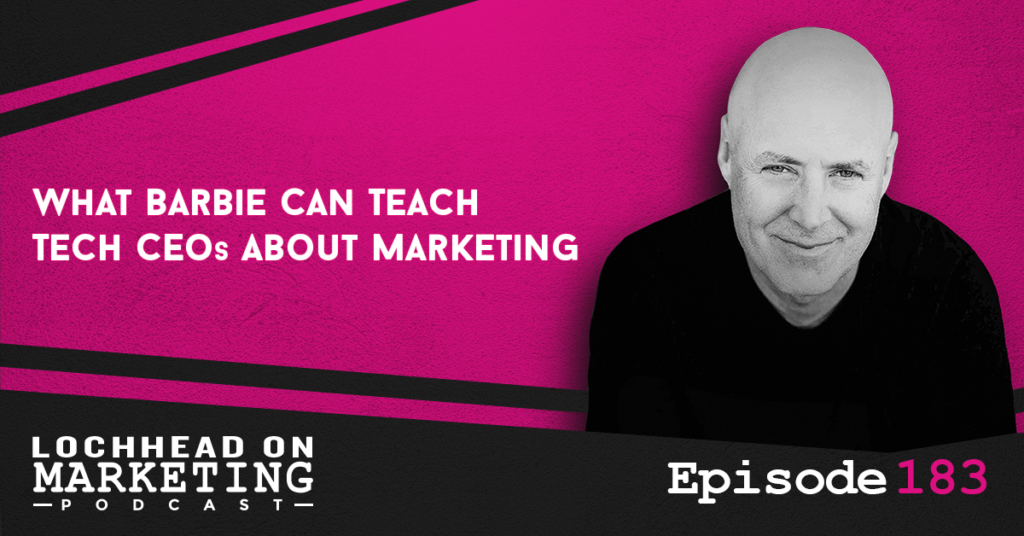
Podcast (lochheadonmarketing): Play in new window | Download (Duration: 8:05 — 5.5MB) | Embed
Subscribe: Apple Podcasts | Spotify | RSS | More
On this episode of Lochhead on Marketing, let’s take a look on what the movie Barbie did to reach such an overwhelming success, and what Tech CEOs can learn about their approach to marketing.
Welcome to Lochhead on Marketing. The number one charting marketing podcast for marketers, category designers, and entrepreneurs with a different mind.
Barbie’s Approach to Marketing
Christopher Lochhead opens up the dialogue with pointing out the things that the Barbie producers did that made it a blockbuster win, particularly with what they did on the marketing side. According to Christopher, Barbie pulled off the greatest “lightning strike” framework of any brand in 2023.
One of the notable things that stood out was that Barbie spent $145M on producing the film, while spending almost $150M on marketing.
Let that sink in: $145M to make it, $150M to build it up.
Most companies would consider it outrageous to do such a thing, opting to focus their resources on building the product and spending what’s left on marketing, if any. And this is why most of those companies fail to make a mark and carve out a market early on in their product’s lifecycle.
How about Barbie? Well, it spent a combined $295M, but that marketing approach resulted in $1B in sales. $145M to make it, $150M to build. $1B in revenue.
Barbie’s Missed Opportunity
That said, Christopher did point out a few missed avenues that Barbie could’ve made to take advantage of their marketing strategy. For one thing, they left the digital space widely untapped, spawning newsletters and enticing new generations of girls to getting into collecting Barbies and other related merchandise.
Another thing they could’ve done is get older fans together and start building out a community in the digital sphere and talk all things Barbie. Not only does it heavily hit people in their nostalgia, but it can also help expose those older generation’s children into Barbie, and then you are back to point no. 1.
The Recession that Never Came
One of the things that Christopher also noticed with Barbie’s approach is that people are still bracing for a recession that seemingly never came, or at least was not as full-blown as we were expecting it to be. While everyone else was still timidly testing the waters, Barbie decided it would make a big splash instead.
So for Tech CEOs out there, it may not be the time to be holding down the fort. Rather, it should be a good time to try and hurl some lightning strikes in the market and see if you strike gold.
To hear more about Christopher Lochhead’s views on Barbie’s success and how it can teach tech CEOS about marketing, download and listen to this episode.
Bio
Christopher Lochhead is a #1 Apple podcaster and #1 Amazon bestselling co-author of books: Niche Down and Play Bigger.
He has been an advisor to over 50 venture-backed startups; a former three-time Silicon Valley public company CMO and an entrepreneur.
Furthermore, he has been called “one of the best minds in marketing” by The Marketing Journal, a “Human Exclamation Point” by Fast Company, a “quasar” by NBA legend Bill Walton and “off-putting to some” by The Economist.
In addition, he served as a chief marketing officer of software juggernaut Mercury Interactive. Hewlett-Packard acquired the company in 2006, for $4.5 billion.
He also co-founded the marketing consulting firm LOCHHEAD; the founding CMO of Internet consulting firm Scient, and served as head of marketing at the CRM software firm Vantive.
Don’t forget to grab a copy (or gift!) of one of our best-selling books:
Snow Leopard: How Legendary Writers Create A Category Of One
The Category Design Toolkit: Beyond Marketing: 15 Frameworks For Creating & Dominating Your Niche
A Marketer’s Guide To Category Design: How To Escape The “Better” Trap, Dam The Demand, And Launch A Lightning Strike Strategy
 The 22 Laws of Category Design: Name & Claim Your Niche, Share Your POV, And Move The World From Where It Is To Somewhere Different
The 22 Laws of Category Design: Name & Claim Your Niche, Share Your POV, And Move The World From Where It Is To Somewhere Different
We hope you enjoyed this episode of Lochhead on Marketing™! Christopher loves hearing from his listeners. Feel free to email him, connect on Facebook, Twitter, Instagram, and subscribe on iTunes!
182 Is Twitter’s Rebrand to X a Category Design Play? | Pirates Perspective
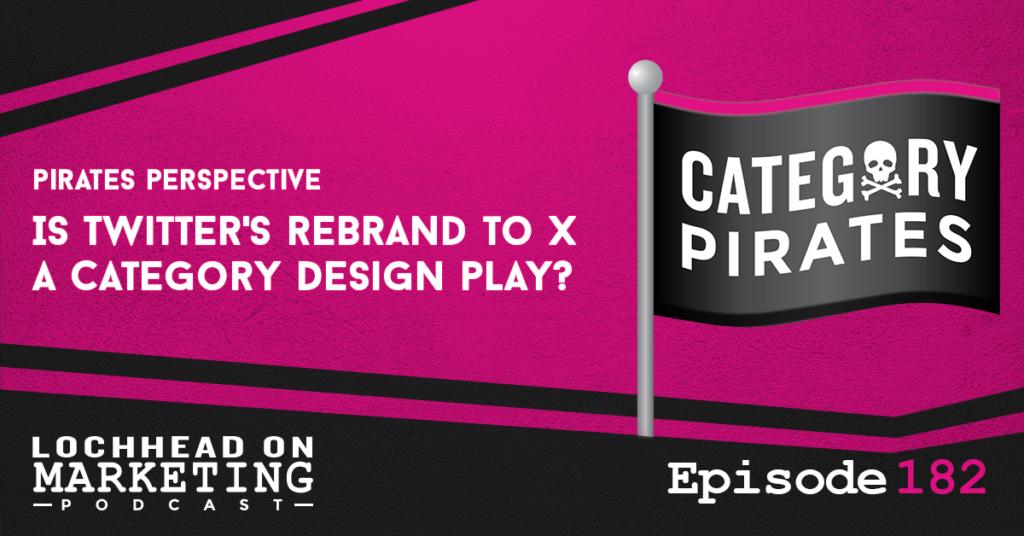
Podcast (lochheadonmarketing): Play in new window | Download (Duration: 17:26 — 12.0MB) | Embed
Subscribe: Apple Podcasts | Spotify | RSS | More
On this episode of Lochhead on Marketing, we are presenting some Pirates Perspective from our newsletter, Category Pirates.
Eddie Yoon, Christopher Lochhead and Katrina Kirsch of Category Pirates discuss Elon Musk’s recent move to rebrand Twitter to X. They also speculate why Elon made such a move, and what he could have done from a category design perspective.
Welcome to Lochhead on Marketing. The number one charting marketing podcast for marketers, category designers, and entrepreneurs with a different mind.
Twitter to X
Elon Musk’s choice to rename Twitter as X has left people puzzled, questioning why he would give up a well-known brand and introduce a new one. Katrina follows up that the others think the move might be aimed at entering a different category, possibly related to financing. She wonders whether it would have been wiser to create a new company instead of rebranding Twitter.
Eddie Yoon discusses the debate surrounding the cost of rebranding and the value of legacy brand identity. He highlights that classic economic theory suggests ignoring sunk costs, which are expenses from the past, and instead focusing on future opportunities.
Eddie mentions that while some argue against rebranding due to the value of Twitter’s legacy brand, most consumers prioritize what a brand can offer them in the future rather than its past reputation. He suggests that rebranding can make sense when a company wants to enter new categories and emphasizes the importance of looking towards future opportunities rather than dwelling on the past. In Musk’s case, he’s not banking on the legacy of the brand itself, but the established userbase that Twitter has, who have a high potential of also buying in to what new category Twitter, now X, might become.
Elon Musk’s Mistake with the rebrand
While Christopher Lochhead agrees with Eddie Yoon’s points, he also believes that Elon Musk made a mistake by rebranding Twitter without clearly unveiling his vision for the new category of service he wants to create. He argues that a rebrand should be part of a strategic launch of a new category and not just a standalone action. The value of a brand lies in its perceived leadership in a relevant category, and in this case, the microblogging category may not be as impactful as before.
Although Elon Musk’s approach might not align with the ideal category design strategy, his reputation and influence will likely still garner attention when he eventually presents his big vision for the new category. But it definitely will lose some steam because the rebrand has become open to interpretation, rather than being focused on the intended category creation.
X as a financial category
The three further discuss the possibility of X creating a new currency or incorporating cryptocurrencies into its platform. Eddie mentions that X is already experiencing a shift in money flow, with revenue coming from both advertisers and users.
They also speculate that Elon Musk might have plans to introduce financial services or a new token (X token) on Twitter/X, incentivizing creators and potentially offering various payment options, including cryptocurrency. They compare this potential move to American Airlines’ frequent flyer program, which essentially created a currency in the form of loyalty points.
While they acknowledge they don’t have insider information, they highlight that Musk’s background with PayPal and his desire to make X a vital part of everyone’s life might lead to interesting developments.
To hear more about the discussion on what Elon plans to do with X, download and listen to this episode. If you want to join in the discussion, subscribe to Category Pirates and find more Pirates Perspective buried around the beach.
Don’t forget to grab a copy (or gift!) of one of our best-selling books:
Snow Leopard: How Legendary Writers Create A Category Of One
The Category Design Toolkit: Beyond Marketing: 15 Frameworks For Creating & Dominating Your Niche
A Marketer’s Guide To Category Design: How To Escape The “Better” Trap, Dam The Demand, And Launch A Lightning Strike Strategy
 The 22 Laws of Category Design: Name & Claim Your Niche, Share Your POV, And Move The World From Where It Is To Somewhere Different
The 22 Laws of Category Design: Name & Claim Your Niche, Share Your POV, And Move The World From Where It Is To Somewhere Different
We hope you enjoyed this episode of Lochhead on Marketing™! Christopher loves hearing from his listeners. Feel free to email him, connect on Facebook, Twitter, Instagram, and subscribe on iTunes!
181 My First Year As A Category Designer with Mike Bruno of Play Bigger
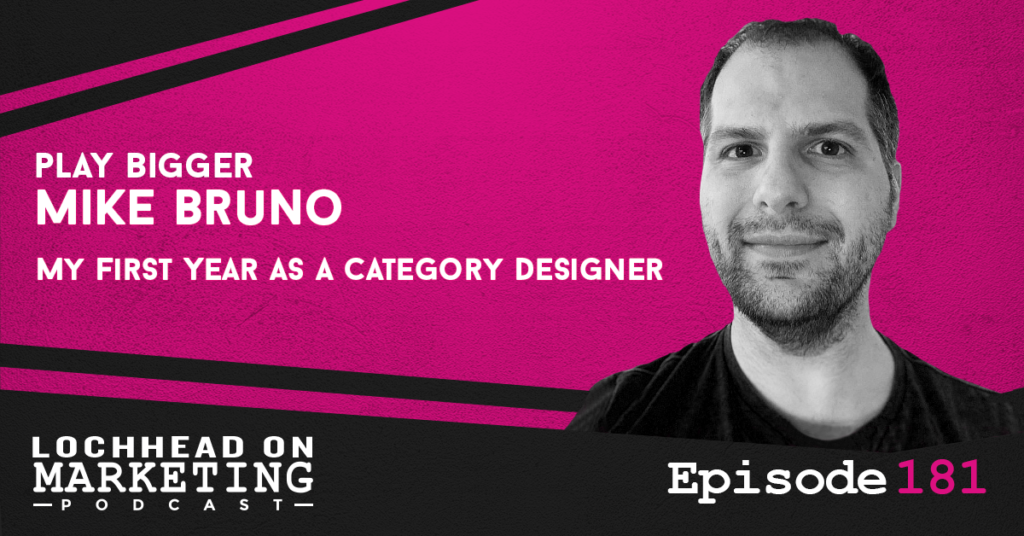
Podcast (lochheadonmarketing): Play in new window | Download (Duration: 1:07:43 — 46.5MB) | Embed
Subscribe: Apple Podcasts | Spotify | RSS | More
On this episode, we welcome Mike Bruno, Senior Category Designer at Play Bigger. Today, we dig into what it takes to make Category Design your career, and how incredible it is working with some of the most advanced technology companies in the world on category design.
Welcome to Lochhead on Marketing. The number one charting marketing podcast for marketers, category designers, and entrepreneurs with a different mind.
Mike Bruno and his first year as a Category Designer
Mike, who has been a category designer for about a year and a half, started his career working in agencies and social advertising. Transitioning into category design was a return to a beginner mindset for him, which he found interesting. In his previous role, he helped people solve problems and develop strategies based on business objectives and existing products. This experience translated well to category design, where the front door is identifying the problem that the category solves uniquely.
Mike also mentioned that category design involves many new concepts and a broader aperture, as it requires structuring not only the client’s business but also influencing the entire market. While it was a humbling experience trying to figure it all out, he also had a sense of familiarity, knowing how to approach problems and strategize effectively.
Overall, his first year as a category designer was challenging and exciting, with a mix of the familiar and the new, which kept him engaged and interested in the field.
The way people think about Category Design
Christopher and Mike discuss the challenges of transitioning from traditional marketing to category design. They emphasize that category design involves creating new markets rather than catching existing demand. Mike points out that realizing someone invented categories was a facepalm moment for him, but it made him realize the importance of solving unsolved problems.
Christopher and Mike also talked about the power of not doing anything, meaning finding a category that has already been solved, and how this is often underestimated in the business world. They use Apple’s example of launching a new category called “spatial computing” instead of just a new product like most marketers do. They compare it to Magic Leap, which failed to create a category despite having inspiring visions. Mike believes Apple succeeded because they could bridge the gap between their vision and the technology needed to achieve it.
Mike Bruno on the Difference between Category Design and Product Design
Christopher and Mike discuss the difference between launching a product and category designing a market category. They use the example of Magic Leap, which had a product but failed to category design the spatial computing market. Christopher explains that category design involves framing, naming, and claiming a new problem, creating an ecosystem of partners to solve that problem, and evangelizing the solution.
Mike shares his surprise about the comprehensive nature of category design, realizing that it’s not just about coming up with a new term but involves a rigorous process to make the category successful. They also mention Apple’s success in category designing the spatial computing market, positioning themselves for significant market cap growth while other players who only launched products may miss out on the opportunity.
To hear more from Mike Bruno and his experiences as a Category Designer, download and listen to this episode.
Bio
Mike Bruno
Mike is a Senior Category Designer with a background in psychology and communications strategy. He finds hidden problems and unspoken truths, and connects those with companies, brands and products to drive businesses and, importantly, the people they serve.
Mike’s style of Category Design is simple, straightforward and playful. His work is equally influenced by the behavioral sciences, business theory and imagination. Carl Jung on one shoulder, and Dav Pilkey on the other.
Mike’s work has been featured in Advertising Age’s “Book of Tens”, has been awarded numerous industry accolades and has driven double digit brand growth for dozens of clients. Outside of work, Mike is a frequent guest lecturer at NYU and The New School, a hockey coach to five-year-olds, and a father of two boys. He lives in Westchester, NY with his wife, kids and backyard ice rink.
Don’t forget to grab a copy (or gift!) of one of our best-selling books:
Snow Leopard: How Legendary Writers Create A Category Of One
The Category Design Toolkit: Beyond Marketing: 15 Frameworks For Creating & Dominating Your Niche
A Marketer’s Guide To Category Design: How To Escape The “Better” Trap, Dam The Demand, And Launch A Lightning Strike Strategy
 The 22 Laws of Category Design: Name & Claim Your Niche, Share Your POV, And Move The World From Where It Is To Somewhere Different
The 22 Laws of Category Design: Name & Claim Your Niche, Share Your POV, And Move The World From Where It Is To Somewhere Different
We hope you enjoyed this episode of Lochhead on Marketing™! Christopher loves hearing from his listeners. Feel free to email him, connect on Facebook, Twitter, Instagram, and subscribe on iTunes!
180 How Important is Framing, Naming, & Claiming a Problem? | Pirates Perspective
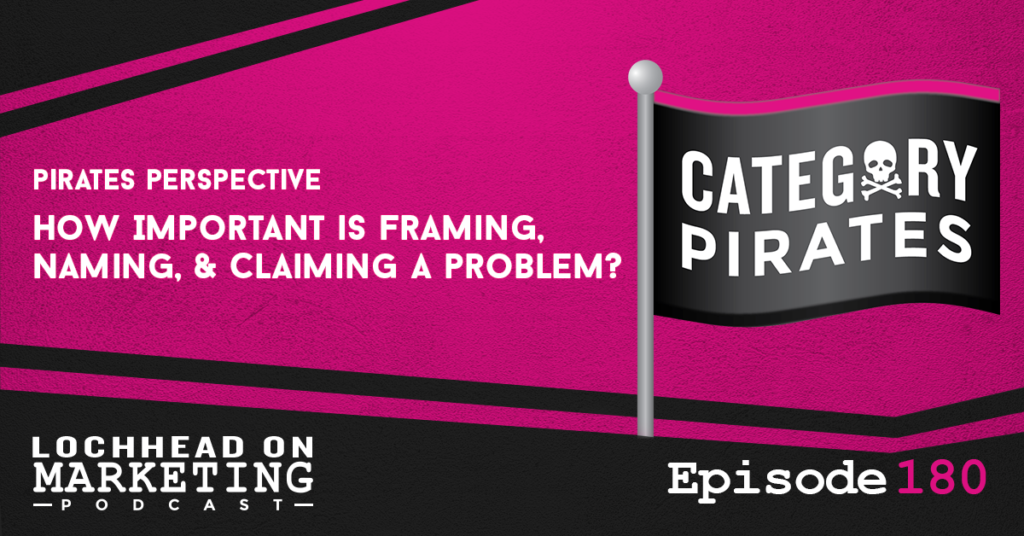
Podcast (lochheadonmarketing): Play in new window | Download (Duration: 11:13 — 7.7MB) | Embed
Subscribe: Apple Podcasts | Spotify | RSS | More
On this episode, we are presenting some Pirates Perspective from our newsletter, Category Pirates.
Eddie Yoon, Christopher Lochhead and Katrina Kirsch of Category Pirates discuss why it’s crucial to frame, name, and claim a problem when designing a category and marketing it to customers. They also discuss why companies struggle to articulate their problems, and explain what happens if they fail to properly language it.
Welcome to Lochhead on Marketing. The number one charting marketing podcast for marketers, category designers, and entrepreneurs with a different mind.
The three most important things a company does at the highest levels
When asked about the problem that category design solves, Christopher emphasizes three key aspects. Firstly, it is important to believe that there are three crucial elements for a successful company: designing a legendary company/business model, offering legendary products/services, and creating a legendary category. These three aspects are considered the most important things a company does. If someone does not agree with this belief, he thinks that there is no basis for further discussion.
Secondly, it is necessary to acknowledge the significance of taking ownership and authorship of the category. If someone is willing to assume this responsibility, then assistance can be provided. However, if they are not interested in this aspect, there is no intention to convince or persuade them.
“That’s the difference between you walking in the dojo and us standing outside the dojo and dragging you into it.”
– Christopher Lochhead
Would you rather capture the 76% or compete for the 24%?
Eddie Yoon emphasizes the importance of category design in capturing the market. He argues that if one does not recognize the significance of category design, then other considerations become irrelevant. If it is agreed that category design is important, it must be acknowledged that it should be pursued wholeheartedly.
Eddie suggests that the question of why naming, framing, and claiming are important is essentially a question about the importance of category design itself. He states that if one does not understand the essence of category design, they cannot effectively address the first question.
He presents a scenario where capturing 76% of the category economics is compared to competing for the remaining 24% with a better or faster, cheaper version. Eddie suggests that many people are actually comfortable with the smaller percentage because it is familiar and known. However, if someone is content with competing for the smaller share, Eddie acknowledges their choice and states that traditional business strategies and teachings will suffice for that situation.
Ultimately, Eddie highlights the importance of understanding one’s preference for a larger or smaller market share and reframing the perspective accordingly.
Unlearning the 24% way
Eddie Yoon discusses the necessity of unlearning old and “comfortable” ways in order to capture the 76% of the market. He emphasizes that choosing to pursue the larger market share requires a significant amount of unlearning.
Part of this unlearning process involves freeing oneself to focus on understanding and articulating the problem at hand. Eddie compares it to Mark Twain’s quote about not having time to write a short letter, which highlights the importance of concise and effective communication. Framing, naming, and claiming the problem are essential because without the ability to express it clearly, important details can be lost in subsequent conversations with coworkers, investors, or customers. This loss of clarity can lead to a diluted understanding of the value proposition.
Eddie explains that without a clear understanding of the problem and its articulation, customers may not perceive the worth or premium of the product or service, investors may question the multiple premiums, and employees may not see the value of choosing the company over competitors focusing on the smaller market share.
Don’t forget to grab a copy (or gift!) of one of our best-selling books:
Snow Leopard: How Legendary Writers Create A Category Of One
The Category Design Toolkit: Beyond Marketing: 15 Frameworks For Creating & Dominating Your Niche
A Marketer’s Guide To Category Design: How To Escape The “Better” Trap, Dam The Demand, And Launch A Lightning Strike Strategy
We hope you enjoyed this episode of Lochhead on Marketing™! Christopher loves hearing from his listeners. Feel free to email him, connect on Facebook, Twitter, Instagram, and subscribe on iTunes!
179 Why Do Some Companies Ship Products And Very Few Category Design Markets? | Pirates Perspective
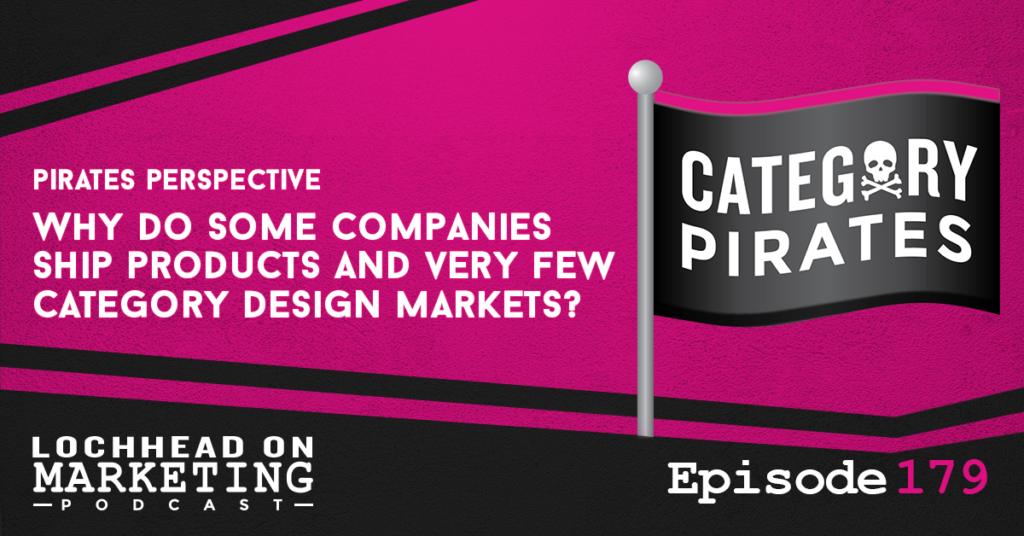
Podcast (lochheadonmarketing): Play in new window | Download (Duration: 14:34 — 10.0MB) | Embed
Subscribe: Apple Podcasts | Spotify | RSS | More
On this episode, we are presenting some Pirates Perspective from our newsletter, Category Pirates.
Eddie Yoon, Christopher Lochhead and Katrina Kirsch of Category Pirates discuss why some companies ship products, but very few companies category design markets. They explain this through the lens of Apple’s new Vision Pro spatial computing headset in talk about why Apple’s approach is different.
Welcome to Lochhead on Marketing. The number one charting marketing podcast for marketers, category designers, and entrepreneurs with a different mind.
Apple has always been Category First, Product Second
Katrina Kirsch starts off the conversation with how a lot of companies tend to put out products, and not focus on creating a category for them first. Apple seems to be the biggest contrary to this statement, as it has always been a category-driven company rather than product driven.
Eddie Yoon agrees with this, and adds that Apple has never been one to create a product first, or a first-mover. Even going as far as the first Mac, there have been personal computers before it, but Apple sold people to a whole new experience by creating a category around personal computers and having an interface that’s both intuitive and easy to get into.
Copying vs Innovating
Following up to this, there are those who say that Apple is just copying ideas from its competitors and adding their own quirk to it. But if you look at this deeper, Apple is just really good at finding different uses for existing products in the market, something that those who made it first didn’t even consider as a function.
Take for example what Apple is doing to the Vision Pro right now, which was discussed by Christopher in the previous Lochhead on Marketing episode (LOM 178). The main difference with how Google and other virtual headset devices marketed themselves versus the clear-cut presentation and demonstration by Apple is just miles apart. It doesn’t just look like a proof of concept that people can experiment on: Apple clearly tells you, “This is what you can do with it, and what other things you can add on later.”
Apple is attacking the “tyranny of the screen”
Christopher then explains that a lot of people misunderstood Apple’s point of attack in launching the Vision Pro. As product-centric companies and businesses, they think Apple is attacking other products like the Oculus and other VR headsets. When in reality, Apple is aiming for something else.
As Eddie Yoon puts it, Apple is attacking the tyranny of the screen. The concept that we have to get bigger screens when we want better entertainment value, or that we have to be tied down to a certain place when doing work because your display cannot move with you.
The other misconception is that people say Apple did not invent spatial computing. That it has been there this whole time in other products. And that’s true. But they are one of the first to adopt it to a question that only spatial computing can solve, and not just push out a product to see what people will do to it. This gives Apple app developers a range that they can work with; a clear scope and limitation so they don’t overshoot their promises, but at the same time push the boundaries of what can be done with it.
To hear more about these Pirates Perspectives, download and listen to this episode. And if you like to hear more Pirates Perspectives, you can find it and other buried treasures when you subscribe to our Category Pirates newsletter.
Don’t forget to grab a copy (or gift!) of one of our best-selling books:
Snow Leopard: How Legendary Writers Create A Category Of One
The Category Design Toolkit: Beyond Marketing: 15 Frameworks For Creating & Dominating Your Niche
A Marketer’s Guide To Category Design: How To Escape The “Better” Trap, Dam The Demand, And Launch A Lightning Strike Strategy
We hope you enjoyed this episode of Lochhead on Marketing™! Christopher loves hearing from his listeners. Feel free to email him, connect on Facebook, Twitter, Instagram, and subscribe on iTunes!
178 Apple’s New Category Design & Why(almost) No One Got It
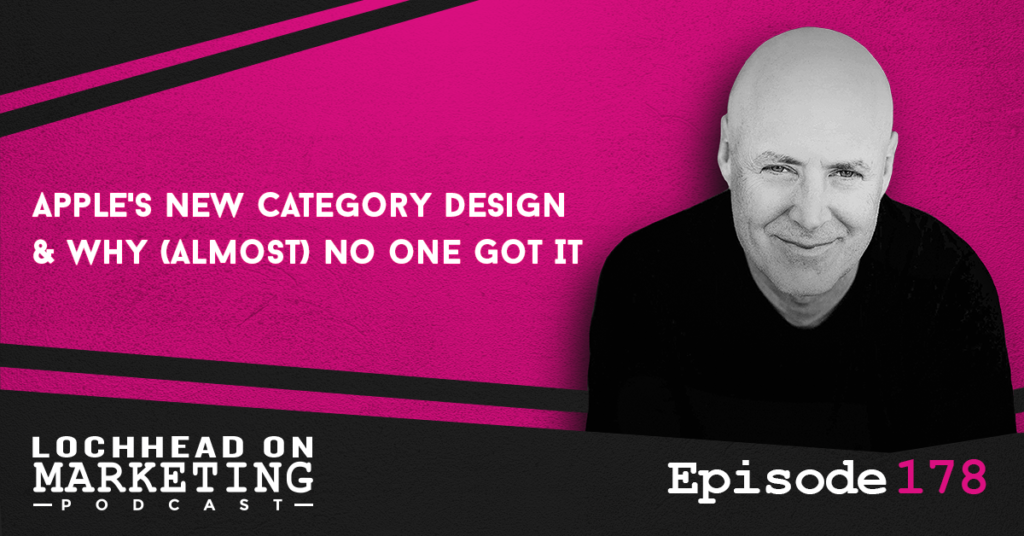
Podcast (lochheadonmarketing): Play in new window | Download (Duration: 8:42 — 6.0MB) | Embed
Subscribe: Apple Podcasts | Spotify | RSS | More
Apple announced some powerful new stuff at their Worldwide Developer Conference. And, as usual, many people in the business press, Twitter, and in Silicon Valley didn’t see what happened in plain sight. So here we are again, explaining why this new category is different from the other virtual and reality augmentation devices out there, and why it is important.
Welcome to Lochhead on Marketing. The number one charting marketing podcast for marketers, category designers, and entrepreneurs with a different mind.
Don’t just launch products, launch categories
Let me put it to you this way. Google launches products, aka Google Glass. Facebook, launches products, aka Oculus. Meanwhile, Apple does Category Design.
It’s fascinating to us that category design hides in plain sight. Because what most people got wrong is they think that Apple introduced a product called Vision Pro. And yes, of course, they did that. But they did not make the same mistake that Google and Facebook made, which is they just launch products; Apple designs categories. And they tell you that’s exactly what they’re doing.
Press Release for Apple Vision Pro
Here’s the headline: introducing Apple Vision Pro, Apple’s first spatial computer.
And what you have is the new product and brand Apple vision Pro. And they tell you what it is. It’s a spatial computer. It’s not a VR/AR headset. It’s not some kind of other variety – It’s a spatial computer. And if you go on to read the press release, what you’ll discover is that Tim Cook’s quote sums the whole thing up. “Today marks the beginning of a new era for computing,” said Tim Cook, Apple’s CEO. Just as the Mac introduced us to personal computing, and iPhone introduced us to mobile computing, Apple Vision Pro introduces us to spatial computing. And that, my friends, is the difference between marketing a category and just a product.
Creating a new computing platform
And this is what most people miss. And the reason they did it at their worldwide developer conference, is because they want the vision pro spatial computer to become a new compute platform. Just like the iPhone became a new compute platform, the personal computer became a new compute platform. That’s what they’re doing here. The iPad, etc. became a new platform, a new category of technology, not just a product that they gave to people.
Launching a product without a category is like a loose cannon
When Google launched Google Glass, they launched a product, they never articulated a problem that that product solved. They never evangelized a different future with that product. What they did was show a bunch of features. And because they didn’t provide the strategic context for understanding of what the product was, aka category, they left it up to customers and the media to decide.
Well, what happened? If you don’t control your own category narrative, somebody else will. And so what emerged about Google Glass? Well, number one, because they did the launch in Silicon Valley, the people who used it immediately got the nickname of “glass-holes”, because it was rich assholes using Google Glass and beta and early release driving around in their Tesla’s and the like, that sort of drew the ire of much of the world.
To hear more on what Apple did right with the launch of their new category, download and listen to this episode.
Bio
Christopher Lochhead is a #1 Apple podcaster and #1 Amazon bestselling co-author of books: Niche Down and Play Bigger.
He has been an advisor to over 50 venture-backed startups; a former three-time Silicon Valley public company CMO and an entrepreneur.
Furthermore, he has been called “one of the best minds in marketing” by The Marketing Journal, a “Human Exclamation Point” by Fast Company, a “quasar” by NBA legend Bill Walton and “off-putting to some” by The Economist.
In addition, he served as a chief marketing officer of software juggernaut Mercury Interactive. Hewlett-Packard acquired the company in 2006, for $4.5 billion.
He also co-founded the marketing consulting firm LOCHHEAD; the founding CMO of Internet consulting firm Scient, and served as head of marketing at the CRM software firm Vantive.
Don’t forget to grab a copy (or gift!) of one of our best-selling books:
Snow Leopard: How Legendary Writers Create A Category Of One
The Category Design Toolkit: Beyond Marketing: 15 Frameworks For Creating & Dominating Your Niche
A Marketer’s Guide To Category Design: How To Escape The “Better” Trap, Dam The Demand, And Launch A Lightning Strike Strategy
We hope you enjoyed this episode of Lochhead on Marketing™! Christopher loves hearing from his listeners. Feel free to email him, connect on Facebook, Twitter, Instagram, and subscribe on iTunes!
177 Should My Category Name Be Relevant And Relatable? | Pirates Perspective
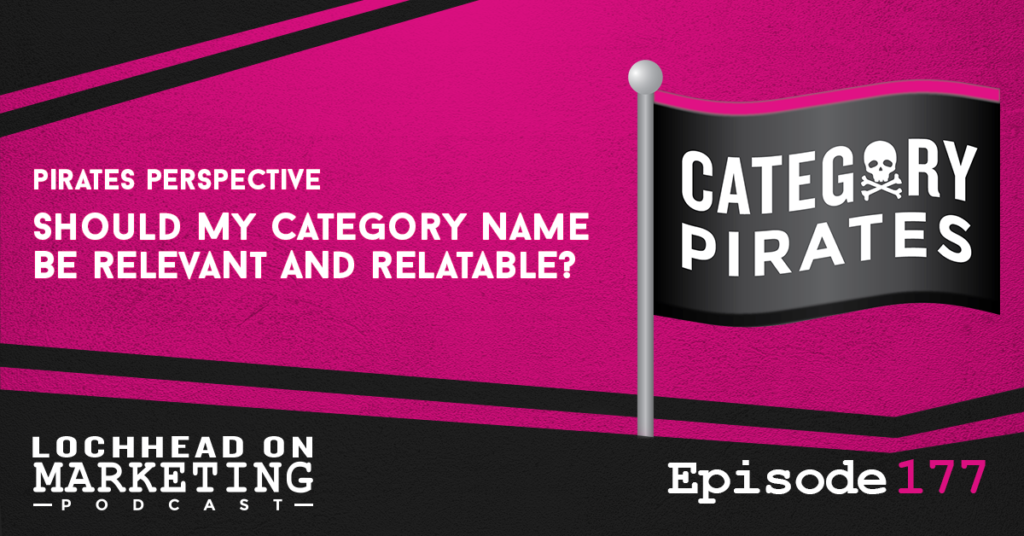
Podcast (lochheadonmarketing): Play in new window | Download (Duration: 9:40 — 6.6MB) | Embed
Subscribe: Apple Podcasts | Spotify | RSS | More
On this episode, we are presenting some Pirates Perspective from our newsletter, Category Pirates.
Eddie Yoon and Christopher Lochhead of Category Pirates answer questions about how important it is to create a category name that resonates with people—and that is similar enough to everyday language. Languaging takes thinking, but it’s worth getting right.
Welcome to Lochhead on Marketing. The number one charting marketing podcast for marketers, category designers, and entrepreneurs with a different mind.
The importance of a Category Name entering the mainstream
The first topic comes from a question about the importance of having a category name, and how important it is to be relevant enough to be used in everyday speech and lingo.
Eddie points out that it is every important and a great deal to have one’s category name be something recognized by the public, particularly the target consumers, while striking a balance of being unique and different from the rest.
An example he gives is Starbucks, which is in the “Dessert Coffee” business. While they might not outright say that they are in such as business, how they portray their products is perceived by consumers as such. And they capture that particular market by Languaging, creating something new like the Frappuccino.
Having your Category Name make a mark in people’s minds
Continuing along that line of thought, Eddie Yoon emphasizes that it is not only important to create something new, but it is also important that people find it relevant and want to engage with your product or service.
Going to the example of Starbucks again, people have had coffee before, but they have not had dessert coffee. And say what you will, Frappuccino is essential a liquid sugar bomb in a cup, which a lot of people find more interesting than your regular latte or cappuccino.
And where can you buy this Frappuccino? That’s right, Starbucks.
Nowadays, there are numerous coffee shops that use the term, but whenever one thinks of Frappuccino, Starbucks is one of the first things that come to mind. And that is how you make a mark in people’s minds.
Combining Ideas to make a new innovative Category Idea
Christopher Lochhead then brings up the topic of combining two or three ideas to make a new Category Idea. Sometimes, those ideas can even clash with each other individual, but makes sense when you combine them.
An example of this was Sun Microsystems, which went all-in for networking earlier than everyone else. While people are still using their computers as standalone units in business, Sun Microsystems have been selling servers and advocated for business to build a network for their office PCs. They even have their own networking software called Solaris.
So while the business people in the 90’s finally had their delayed A-ha! moment, Sun Microsystems have already carved up a sizable chunk of the market for themselves.
To hear more about these Pirates Perspectives, download and listen to this episode. And if you like to hear more Pirates Perspectives, you can find it and other buried treasures when you subscribe to our Category Pirates newsletter.
Don’t forget to grab a copy (or gift!) of one of our best-selling books:
Snow Leopard: How Legendary Writers Create A Category Of One
The Category Design Toolkit: Beyond Marketing: 15 Frameworks For Creating & Dominating Your Niche
A Marketer’s Guide To Category Design: How To Escape The “Better” Trap, Dam The Demand, And Launch A Lightning Strike Strategy
We hope you enjoyed this episode of Lochhead on Marketing™! Christopher loves hearing from his listeners. Feel free to email him, connect on Facebook, Twitter, Instagram, and subscribe on iTunes!
176 How AI Changes Startups, Entrepreneurship & Venture Capital with Mike Maples Jr. of Floodgate
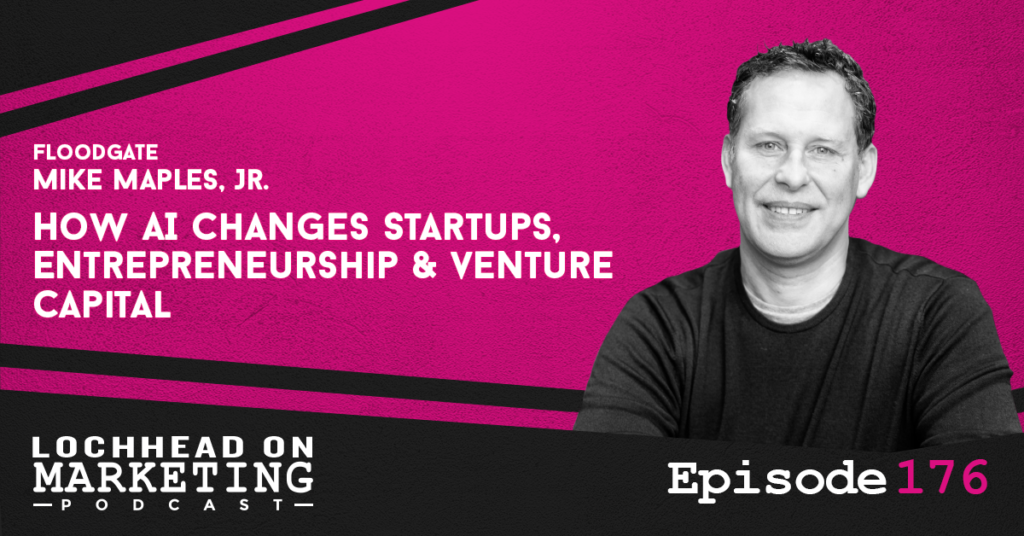
Podcast (lochheadonmarketing): Play in new window | Download (Duration: 39:09 — 26.9MB) | Embed
Subscribe: Apple Podcasts | Spotify | RSS | More
On this episode of Lochhead on Marketing, we have a dialogue with Mike Maples Jr. on how artificial intelligence is changing startups and venture capital.
Mike Maples Jr. is the co-founder of Floodgate, one of the highest profile early stage venture capitalists. He also has a podcast called Starting Greatness, and it is one of my absolute favorites.
By the end of it, we hope that you’ll gain a new way to think about both technical risk for startups and market risk. And why in an AI world, you must either be radically different or radically disintermediate something.
Welcome to Lochhead on Marketing. The number one charting marketing podcast for marketers, category designers, and entrepreneurs with a different mind.
Mike Maples Jr. on AI
We begin the discussion on the topic of challenges of making sense of the rapidly evolving field of AI.
Mike also talks about the traditional funding model of startups, where the primary focus was taking out technical risk, and how the LAMP stack, which commoditized what was once expensive, made it easier to start a startup. Mike notes that the nature of the LAMP stack changed what startups were funded for.
“What I like to say is that the LAMP stack was deflationary in terms of the cost of starting startup. And so what does that mean? It meant that what you were funding was different, because if Kevin Rose can start dig for $1,500, over a weekend, there’s no technical risks there. I mean, he hired a contractor to do it that he didn’t even know at the time.”
– Mike Maples Jr.
Who gets Product Market Fit first
The conversation then moves on to the changing dynamics of venture capital investment. The discussion continues with the notion that technical risk and market risk are inversely related. Solving a technically difficult problem that is valuable to society will create a market; if the problem is easy to solve technically, it will all come down to who achieves product-market fit first.
To add value to the business, Floodgate and YC have taken the approach of funding market risk takedown. As technology becomes more commoditized and innovations become more accessible, the person who creates something people want the quickest wins. This is why YC was so successful: it offered young people $100,000 to either take market risks or leave.
He also mentions that the traditional venture capital model may not be appropriate for all businesses and that deflationary factors such as content, code, and data may change the way businesses are built.
Mike Maples Jr. on AI and the future of Venture Capital
Mike Maples Jr. then returns to the topic of artificial intelligence and its implications for the future of venture capital.
Here, Mike emphasizes two ends of the risk spectrum: high technical risk and high market risk. On the one hand, some projects require large amounts of funding for mass computation in order to build massive models that have the potential to change humanity. On the other hand, AI is being used in a variety of fields, including content generation for marketing, customer service chatbots, and lead generation, resulting in a deflationary effect on content, code, and data.
According to Mike, some businesses may not require traditional venture capital funding and should instead focus on achieving $50 million in revenue with a small team and minimal funding. There is also speculation that the current billion-dollar funds may be providing the wrong incentives to these companies.
To hear more from Mike Maples Jr. and how AI can affect the future of startups and venture capital, download and listen to this episode.
Bio
Mike Maples Jr. is an entrepreneur turned venture capitalist.
He’s co-founder of Silicon Valley based, early-stage VC Floodgate. And the host of the popular “Starting Greatness” podcast.
Investments include Twitter, Lyft, Bazaarvoice, Sparefoot, Ayasdi, Xamarin, Doubledutch, Twitch.tv, Playdom, Chegg, Demandforce, Rappi, Smule, and Outreach.
Link
Connect with Mike Maples Jr.!
Floodgate | Twitter | LinkedIn | Starting Greatness Podcast
We hope you enjoyed this episode of Lochhead on Marketing™! Christopher loves hearing from his listeners. Feel free to email him, connect on Facebook, Twitter, Instagram, and subscribe on iTunes!

